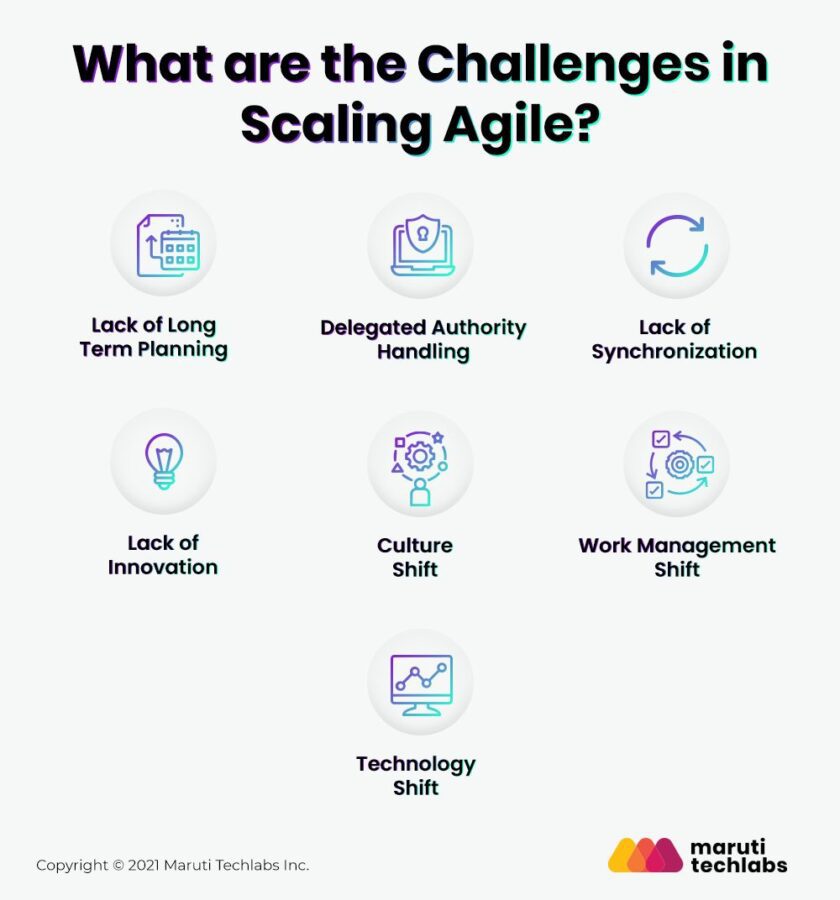
Scaling agile is the process of taking proven agile methods, like scrum and kanban, and using them with a more extensive diverse set of people in larger groups. Traditionally, agile works best in groups that are no bigger than 11 people.
Companies succeed by allowing small groups of employees to define their own goals and design products. They eventually want to apply the same freedoms and successes to a more extensive department. Unfortunately, this is where most companies run into trouble: their people lack consistent motivation and rely too heavily on their managers for instruction. This is where scaling Agile comes in.
Challenges in Scaling Agile
 https://cdn-gcp.marutitech.com/wp-media/2021/10/ea4c197c-scaled-agi… 768w, https://cdn-gcp.marutitech.com/wp-media/2021/10/ea4c197c-scaled-agi… 658w, https://cdn-gcp.marutitech.com/wp-media/2021/10/ea4c197c-scaled-agi… 450w” sizes=”(max-width: 1000px) 100vw, 1000px” />
https://cdn-gcp.marutitech.com/wp-media/2021/10/ea4c197c-scaled-agi… 768w, https://cdn-gcp.marutitech.com/wp-media/2021/10/ea4c197c-scaled-agi… 658w, https://cdn-gcp.marutitech.com/wp-media/2021/10/ea4c197c-scaled-agi… 450w” sizes=”(max-width: 1000px) 100vw, 1000px” />
Transforming the thoughts and execution of work on an organizational level is quite a difficult task. Even most experienced Agile software developers and forward-thinking enterprises face trouble while scaling Agile.
Below are some of the hurdles that an organization faces when it comes to scaling agile principles and practices:
1. Lack of Long Term Planning
Generally, the agile development team implements the SAFe agile methodology to improve their product backlog to two to three iterations.
The product marketing team usually releases the product and performs a high-level roadmap of 12-18 months. Later they co-operate on these plans for three months of work.
The agile development team would clear the backlog for two to three iterations and have detailed task plans ready. New changes are often limited to the subsequent iterations.
2. Delegated Authority Handling
In the Scrum framework, the product owner accepts the charge of the product life cycle accompanied by investment return. There is a requirement to view multiple team backlogs on a larger scale. A product manager is fully accountable for controlling multiple team backlogs. The Product Owner is quite separated from the development of the organization, which leads to a barrier.
3. Lack of Synchronization
The scaled agile framework enables the development team to create their ways of work. There are many development teams at large-scale organizations, and it proves difficult for the team to be entirely self-organized.
The self-organized teams working on similar products will challenge synchronizing their deliverables and delivering them together.
4. Lack of Innovation
In large organizations, additional iteration is required after a release of the product to improve its performance. A large-scale agile model requires testing everything which is operating simultaneously till the end.
5. Culture Shift
Agile is often expressed as a culture instead of a set of principles. The scaled agile framework is often less critical than its culture, but it can be challenging to create.
The Agile expert author, Steve Denning, explains: The elements of a culture fit together as a mutually reinforcing system and combine to prevent any attempt to change it. Single-fix changes at the team level may appear to make progress for a while. Still, eventually, the interlocking elements of the organizational culture take over, and the change is inexorably drawn back into the existing corporate culture.
Dennings prediction is entirely accurate. Agile scaling methods require the entire organization to process, act and react differently in every dimension. Unsuccessful shift to company culture is one of the primary challenges faced by agile transformation failure.
6. Work Management Shift
When transforming an organization to be agile, the culture needs to shift to become more agile. Value-driven organizations are guided by principles that empower people. To be agile, trust must be built throughout the organization for anything that gives value to customers and facilitates agility throughout the company.
The traditional project management approach begins with a fixed goal and estimates the resources and time necessary to achieve that goal. This process defines the requirements of the organization and eventually reduces the risk by increasing success.
On the other hand, the lean-agile model flips the above paradigm. Resources and time become more fixed by establishing iteration windows and teams. Teams experiment and receive feedback quickly so that organizations can adapt nimbly.
Organizations can shift their flow of work in the scaled agile framework by doing the following things:
- Evolve to a more open style of leadership rather than a command and control approach.
- Balance the budget practices from being project-driven to being determined by the value stream.
- Alter the team structure to allow active collaboration and rapid experimentation.
- Modify the communication styles from top-down to more horizontal.
- Update the role of the PMO from the force that dictates how work gets done to the connecting fabric that promotes knowledge across the enterprise.
7. Technology Shift
Organizations working towards scaling agile must be familiar with their technology stack. Scaling agile creates increased visibility, transparency, and information flow across the organization. It means evaluating and augmenting technology solutions.
Technology tools need to support alignment at a tactical level. Development teams cannot scale agile successfully without the right solutions even if the culture and workflow are properly aligned. Which technological tools can smooth scaling agile? The answer depends on the agile maturity of the organization.
If businesses already intake multiple agile teams, scaling agile means implementing a practice connecting them for better transparency and workflow. Going beyond the basics of scaling agile at the team level requires mapping how multiple agile teams are connected in the greater scheme of things. This may mean using a strategic map to view agility capacity at product life cycle phases and across multiple deliverables. The workload can be mapped into actual tasks, financial contributions by team, impact on strategic goals, and ultimately efficiency.
Read full article here
